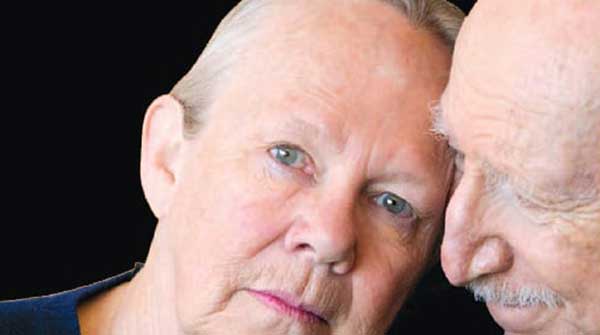Virtual visit program helps people living with dementia in care homes connect with family and friends
Video calls became a lifeline for many people during the restrictions of the early COVID-19 pandemic, allowing families to catch up, employees to work and patients to meet their doctors, all without ever leaving home.
But those calls weren’t always accessible to those who needed them most: people living with dementia in care homes. Now, just as Zoom meetings at work have outlasted pandemic restrictions, a new program aims to make facilitated video calls a standard part of the care for people living with dementia in long-term care, with the goal of improving their quality of life and combating loneliness.

Hannah O’Rourke
 |
| Related Stories |
| Why Canada needs a plan to address dementia and Alzheimer’s
|
| Alzheimer’s leading cause of dementia in an aging population
|
| Key Alzheimer’s risk factors affect men more than women
|
“Connecting Today” is a facilitated virtual visiting program developed by Hannah O’Rourke, assistant professor at the University of Alberta’s Faculty of Nursing. It trains care home staff to facilitate up to 60 minutes per week of calls between care home residents and their family members. A manual for the facilitator includes technical tips and prompts to engage both the resident and the visitor. They may just talk or listen to music together and look at photos — non-verbal interactions that continue to matter to people with even the most severe dementia.
It may seem like a common-sense solution, but using care staff to facilitate virtual calls to connect residents to the people they care about is not offered in every care home. There is limited research exploring whether the facilitation approaches are feasible and engaging for people with moderate or severe dementia, says O’Rourke. Such programs have never been tested for effectiveness.
“The irony of the care home is that residents are surrounded by people, but are those interactions meaningful? Do they have an opportunity to connect with the people who have mattered to them throughout their life?” asks O’Rourke.
O’Rourke has just completed a three-year feasibility study of the program with funding from the Alzheimer Society of Canada and is continuing with a new grant of $100,000 from the Canadian Institutes of Health Research. Next she plans to test the program through a multi-province clinical trial.
“We wanted a program that would support people across all stages of dementia, regardless of their ability to communicate verbally, so they can have meaningful interactions with their family and friends, and potentially expand their network a bit, because oftentimes in care homes they see the same visitor over and over, putting pressure on a single family carer, or they may not receive many visits at all,” O’Rourke explains.
There’s no cure for dementia, which is marked by progressive memory loss and other cognitive decline, but that shouldn’t mean people who live with it can’t live satisfying lives, says O’Rourke. In a scoping review of previous studies involving interviews with people living with dementia, O’Rourke found four factors that individuals identified as most important to their quality of life: a sense of wellness, a sense of purpose, a sense of place and a sense of togetherness.
All of those are highly modifiable factors according to O’Rourke, unlike cognitive impairment, and she set up her research program with a focus on improving social connection.
“Social connectedness is just a human need, and people living with dementia are no different,” O’Rourke insists. “I believe it’s a human right to have social connection and quality of life. People living with dementia in care homes, therefore, require accessible programs that will promote social connection.”
In a soon-to-be-published paper, O’Rourke worked with 21 residents over six weeks, and she reports that 92 per cent demonstrated alertness and pleasure during the video calls. In previously published results, residents’ family contacts rated Connecting Today as a logical, effective, low-risk approach to increasing social connection for their loved ones in care homes.
“We’ve pilot-tested it and had some good results around feasibility and acceptability. People living with dementia and their family and friends demonstrated and described enjoyment during the calls,” O’Rourke says.
“This program will never replace in-person visits and is not intended to — it should augment in-person visits and provide another opportunity for people to connect.”
O’Rourke noted that further study is needed because rigorous evidence is always required when setting new standards in resource-strapped settings such as care homes.
“Any time you do something that requires some staff time (in a care home), you need to make a case that the time spent by a facilitator actually results in improvement in quality of life for the people who are living there, as compared to usual care.”
O’Rourke leads or co-leads two other major projects focused on social connectedness and quality of life for people living with dementia. The first is a project with nursing professor Wendy Duggleby. Duggleby developed online tools to support and educate family caregivers, with demonstrated results showing improvements in their mental health. The pair adapted the program and are evaluating how it may address social isolation and loneliness, with results from their pragmatic trial forthcoming.
“While many different programs could be designed for use in care homes, the thing that binds all of my research projects together is finding accessible ways to help people feel a sense of belonging through their relationships with others.”
| By Gillian Rutherford
This article was submitted by the University of Alberta’s Folio online magazine, a Troy Media Editorial Content Provider Partner.
The opinions expressed by our columnists and contributors are theirs alone and do not inherently or expressly reflect the views of our publication.
© Troy Media
Troy Media is an editorial content provider to media outlets and its own hosted community news outlets across Canada.

